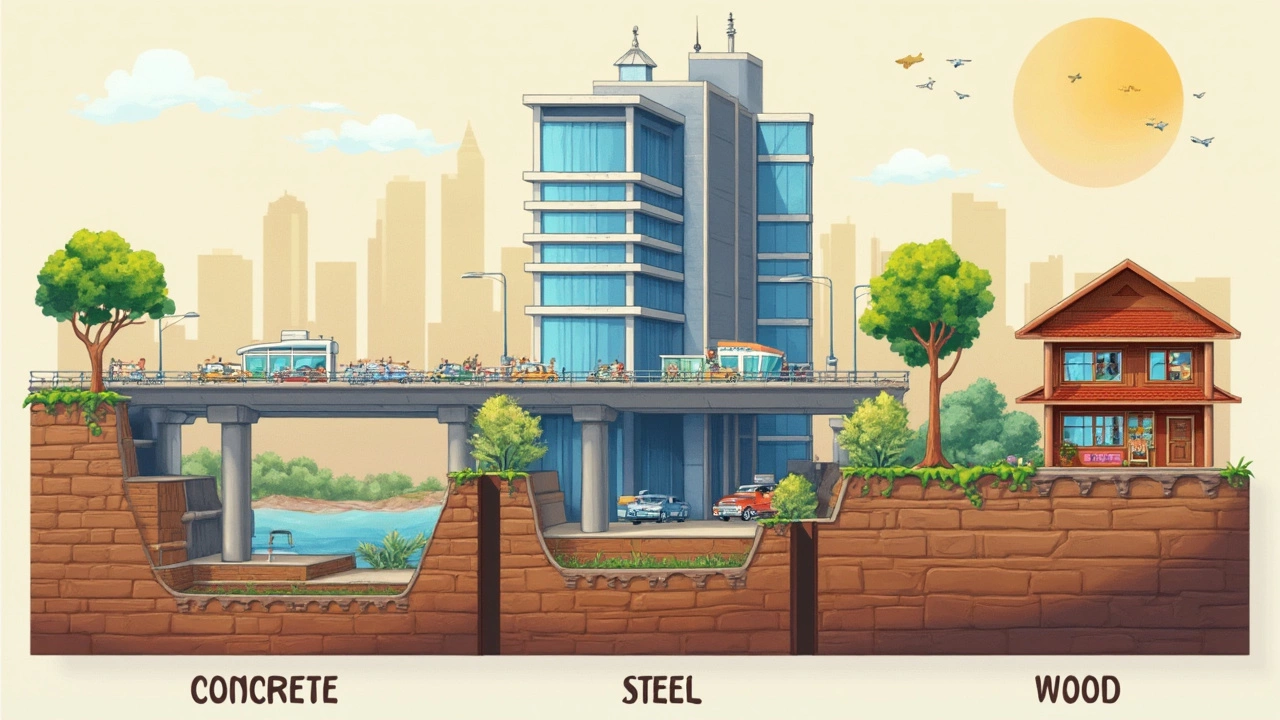Construction Materials: The Big Three You Can't Ignore

Every time you walk past a building site, chances are you’re looking at heaps of concrete, bundles of steel, and stacks of wood. These three materials are basically the building blocks for almost everything you see going up around you. You can find them in skyscrapers, family homes, and bridges—seriously, they’re everywhere.
It’s not just a matter of tradition or habit. There’s a reason builders stick with these staples: they’re reliable, they play to different strengths, and they suit pretty much any budget. Whether you’re thinking of building a house or just want to know what goes into that new mall in your neighborhood, understanding these materials puts you a step ahead.
Ever wonder why your neighbor’s house feels so different from the downtown office tower? Turns out, the answer is mostly about what went into the walls and supports—yep, it’s often these three materials doing all the heavy lifting.
- Why Only Three? The Basics Explained
- Concrete: The Everyday Powerhouse
- Steel: Strength Without the Bulk
- Wood: Nature’s Tried-and-True Choice
- Quick Tips for Choosing the Right Material
Why Only Three? The Basics Explained
Ever wonder why it all comes down to concrete, steel, and wood when people talk about construction materials? It’s not about limiting choices. These three just check off the key boxes every builder needs: strength, cost, easy to work with, and they’re available just about everywhere.
Think about the facts: Concrete is the most-used man-made material on the planet. There’s more concrete made each year than all other building materials combined. Steel can hold up skyscrapers—literally, it’s in the bones of almost every tall building you see. And wood? Still a go-to for homes and smaller projects because it’s simple, sustainable, and gets the job done without crazy expense.
“These materials are the backbone of modern construction. Without them, we wouldn’t have the structures that shape our daily lives.” — Dr. John Cook, Structural Engineer, National Construction Science Institute
Each material has its sweet spot. Concrete’s great for huge surfaces like stadium floors. Steel can handle big loads without taking up tons of space. Wood keeps things lightweight and is easy for the average person to use and fix. Sure, there are fancy options out there—think glass, bamboo, or even plastic—but when builders need something proven, these three are their first picks.
Here’s a quick look at how much we count on these materials every year:
| Material | Annual Global Usage (Approx.) |
|---|---|
| Concrete | 4 billion tons |
| Steel | 1.8 billion tons |
| Wood | 2.2 billion m³ |
If you’re picking a material for your next project, remember: concrete, steel, and wood get chosen because they solve real problems. They keep costs in check, stand up to wear and tear, and they’re trusted by the pros. No surprise they come out on top, year after year.
Concrete: The Everyday Powerhouse
Walk past any construction site, and you’ll spot concrete—on the ground, in walls, supporting floors. This stuff is everywhere for a reason. Concrete is tough, long-lasting, and can be shaped however you want. It’s literally the backbone of most modern builds, from highways to apartment blocks.
What is it exactly? Concrete is made by mixing cement, water, sand, and gravel. Let it sit, and it hardens into rock. That’s why it’s used for everything from sidewalks to huge bridges. One cool fact: worldwide, we use about 30 billion tons of concrete every year. Talk about being in demand.
Builders love concrete because it’s strong under pressure (that’s compressive strength, if you’re the technical type). Think about those massive columns holding up highways—yep, concrete all the way. But it’s not just brute force. You can pour concrete into almost any shape. This makes it easy to use for curved walls, weird angles, or custom patio slabs.
- Super durable—some concrete bridges still work after 100 years.
- Fire-resistant and doesn’t rot, so it’s safe and low-maintenance.
- Can be mixed with steel rebar to make it even stronger (they call this reinforced concrete).
Not everything’s perfect, of course. Concrete takes serious energy to make—producing cement releases a lot of carbon dioxide. But new methods are popping up to make it greener, like using recycled materials or special mixes that trap CO2.
| Feature | Details |
|---|---|
| Compressive Strength | 25 - 50 MPa (typical residential) |
| Major Uses | Buildings, roads, bridges, foundations |
| Average Lifespan | 50-100+ years |
| Annual Global Usage | 30 billion tons |
When you need something that lasts and takes a beating, concrete still wins out almost every time. If you’re planning a project at home—like a driveway or a backyard slab—look for mixes that match your climate (some handle freeze-thaw better). Make sure you let it cure properly, too. That’s how you get the kind of strength you brag to your neighbors about.

Steel: Strength Without the Bulk
If you want something that’s tough but not bulky, steel is the go-to choice in modern construction materials. You see steel frames propping up skyscrapers, warehouses, and even stadiums. The big reason? Steel can handle massive loads without being thick or heavy like concrete.
This material is all about high strength-to-weight ratio. That means you get a lot of strength for not much material, so buildings can be taller and designs more open. Architects love steel because it lets them create big, open spaces without tons of support walls or columns. That’s why those city high-rises or long-span bridges aren’t fat and clunky—they’ve got steel skeletons inside.
Check out these quick facts:
| Fact | Data |
|---|---|
| Tensile Strength | Up to 400-550 MPa (megapascals) |
| Recyclability | Over 90% of structural steel is recycled |
| Fire Resistance | Needs fireproofing coating to maintain strength |
| Common Uses | Beams, columns, bridges, towers |
Another cool thing is that steel can handle earthquakes and wind much better than brittle materials. Because it can bend before snapping, steel buildings stand up to rough weather and quakes a lot better. You might’ve heard about those crazy-fast construction projects in big cities—that’s mostly thanks to steel parts being made offsite and snapped together like giant Lego bricks once they arrive.
Here are some tips for using steel:
- Always budget for rust protection—painting or galvanizing keeps steel safe from moisture.
- If you want to cut construction time, use prefabricated steel pieces.
- Make sure to bring in structural engineers early. Steel lets you do creative stuff, but expert planning is a must.
Steel isn’t just for skyscrapers. Folks use it in houses, especially for open-plan layouts or when extra strong floors are needed (like for a gym in your garage!). It lasts a long time, you can recycle almost all of it, and it gives you flexibility in your building’s look and size.
Wood: Nature’s Tried-and-True Choice
Wood’s been a go-to in construction materials for thousands of years, and for good reason. It's tough, lightweight, and pretty easy to work with. If you’ve ever noticed how fast a wooden house frame goes up compared to other methods, that’s not a coincidence. Carpenters can cut and adjust wood right on site, which saves time and keeps costs down.
Besides that, wood's really good at handling both compression and tension, so it holds up well under weight and stretching. It's also naturally insulated, which helps keep homes warm in winter and cool in summer—something you don't get as much from concrete or steel without extra layers.
When it comes to eco-friendliness, properly managed forests mean wood can be a renewable material. Some types, like Douglas fir and southern pine, grow fast and are perfect for framing while hardwoods like oak work well for floors or trim because they put up with a lot of wear.
Check out some typical uses and quick facts for wood in this table:
| Wood Type | Main Use | Avg. Strength (psi) | Growth Rate |
|---|---|---|---|
| Pine (Softwood) | Framing, Roofing | 8,000 | Fast (20-50 yrs) |
| Oak (Hardwood) | Flooring, Furniture | 16,000 | Slow (60-100 yrs) |
| Douglas Fir | Beams, Joists | 12,400 | Medium (40-60 yrs) |
Here’s a quick checklist when considering wood for your project:
- Check the moisture content. Wet wood warps and can ruin a frame.
- Look for the grade stamp—it tells you if it’s strong enough for structural work.
- Think local. Wood grown nearby is usually cheaper and matches your climate.
- Use pressure-treated wood for anything touching soil or exposed to moisture.
One last tip: Always factor in maintenance. Wood can rot or attract termites if ignored, but regular painting or sealing really keeps it going for decades—or even longer. That’s one reason old wood-framed houses are still standing strong after a century or more.

Quick Tips for Choosing the Right Material
Picking the right construction material can make or break your project—literally. The choice depends on what you’re building, local weather, your budget, and a few trade secrets the pros usually don’t talk about until something goes sideways.
- Concrete rules when you want muscle and long life. If you need something to handle weight or stay put for decades—think driveways, foundations, or anything below ground—concrete’s a safe bet. Just remember, it gets heavy fast, and pouring it in the rain or cold makes a mess.
- Steel is the top pick for reaching high or going wide. If you need a tall building that laughs in the face of wind (like most office towers or sports arenas), you want steel’s strength and flexibility. It costs more up front, but you can save cash and time because you need much less of it compared to wood or concrete.
- Wood works best if you’re after speed and you want to keep costs down—especially for houses or smaller buildings. It’s easier to cut, nail, and fix if something goes wrong. Just don’t trust it on its own in super wet zones or where bugs chew through everything. Pressure-treated lumber helps, but it’s not magic.
Another tip: don’t pick just based on price. Cheap materials often cost you more later in repairs or headaches. Always check if your local codes limit what you can use—some cities ban wood for certain buildings, while others love it for its sustainability. And if noise or privacy matters, concrete and thick wood walls tend to block sound better than steel frames.
Talk to your contractor or builder before you make a call. Odds are, they’ve seen what works—and what doesn’t—right there in your area. A little advice now saves a ton of trouble down the road.
Write a comment